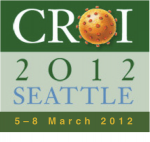Risk of non-AIDS defining malignancies and immune suppression
1 June 2012. Related: Conference reports, Coinfections and complications, CROI 19 (Retrovirus) 2012.
 Simon Collins, HIV i-Base
Simon Collins, HIV i-Base
Non-AIDS defining malignancies have been reported by several groups as increasing in the HAART era, with an association to immune deficiency for some non-virally mediated cancers.
An analysis from the international D:A:D (Data Collection on Adverse events of Anti-HIV Drugs) collaborative cohort, looked at the association between the risk of non-AIDS defining malignancies (NADM), viral suppression and immune recovery.
In an oral presentation, Signe Worm reported an incidence rate (IR) of 4.98/1000 PYFU (95%CI 4.65 to 5.31) from 880 NADM diagnosed in the cohort (>40,000 patients with >176,000 PYFU) between January 2004 and March 2010. Separate incidence rates (IR/1000 PYFU: 95%CI) were collected for the most common malignancies: anal caner (n=79; IR 0.45: 0.35 – 0.55), Hodgkin’s lymphoma (n=112; IR 0.63: 0.52-0.75) and lung cancer (n=140; IR 0.79: 0.66-0.92). These rates were stable over the study period.
Patient characteristics at the time of NADM diagnosis included: 80% male, median age 50 years (IQR 44-59), median CD4 392 cells/mm3 (IQR 245-580), median nadir CD4 127 (IQR 49-245), median viral load 1.7 log copies/mL (IQR 1.7-2.4). Approximately 5% of patients had a prior NADM and 10% a prior ADM. Approximately 35% were current smokers and this was adjusted for in multivariate analysis.
The incidence rates of NADM were inversely associated with all four CD4 markers (latest, nadir, time lagged (6 months prior) and time-averaged CD4 count: incidence rates of 1.0 for CD4 < 100 cells/mm3 dropped to approximately 0.4/100 PYFU with CD4 counts >500 cells/mm3.
Cumulative time spent with a with low CD4 was also significant, with relative rates per additional year of 1.05 (1.04-1.06) and 1.05 (1.03-1.07) for both <100 and <200 cells/mm3 analyses (both p=0.0001). However, no association was seen with recent level of HIV viraemia.
In the multivariate analysis, CD4 count per 50 cells higher (RR 0.97; 95%CI 0.95-0.98, p=0.0001), nadir CD4 < 100 (RR 1.22; 95%CI 1.03-1.44, p=0.02) and duration of suppression <200 cells/mm3, per year (RR 1.04; 95%CI 1.02-1.05, p=0.0001) were associated with risk of NADM.
The association with latest CD4 count was also seen with individual cancers (RR; 95%CI): lung (0.93; 0.89-0.97), Hodgkin’s lymphoma (0.85; 0.81-0.89) and anal cancer (0.93; 0.89-0.98), all per 50 cells/mm3 higher.
Additional factors were nadir CD4 count (<100 cells/mm3) for lung cancer (RR 1.43; 1.00-2.04), viral load AUC (1.35; 1.12-1.63) for Hodgkin’s lymphoma and degree of immunosuppression (<200 cells/mm3) for anal cancer (RR 1.07; 1.05-1.08).
More optimistically, a successful response to ART (increasing CD4 to >200 cells/mm3) was able to overcome the association with CD4 nadir <200 cells/mm3, after two years of treatment.
While not categorised as AIDS defining complications, the association with reduced immune function highlights the importance of earlier HIV diagnosis, prompt use of ART, and perhaps closer monitoring and screening for high risk patients with CD4 counts <200 cells/mm3.
Reference:
Worm S et al. NADM and immunosuppression: the D:A:D study. 19th CROI 2012, Seattle. Oral abstract 130.
http://www.retroconference.org/2012b/Abstracts/44289.htm

